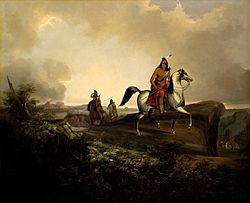Baishan (Apache) facts for kids
Quick facts for kids
Baishan
|
|
|---|---|

Black Knife, painting by John Mix Stanley, 1846.
|
|
| Tchihende Apache leader | |
| Personal details | |
| Born | c. 1796 |
| Died | 1857 (aged 60–61) |
| Known for | principal chief of the Warm Spring Tchihende (Mimbreño Apache) and second-ranking chief of the Tchihende (Mimbreño Apache) after Mangas Coloradas |
| Nicknames | Black Knife, Cuchillo Negro, Knife |
Baishan, also known by his Spanish name Cuchillo Negro (meaning "Black Knife"), was an important Apache leader. He was born around 1796 and passed away on May 24, 1857. Baishan was a chief of the Warm Springs Apache Band, part of the Tchihende (or Mimbreño) Apache people, during the 1830s to 1850s.
Contents
Who Was Baishan?
Baishan, whose name means "Knife," was the son of a famous chief named Fuerte. He became a highly respected war leader among the Tchihende Apache bands for nearly 30 years, starting in the early 1830s. After his father, Fuerte, died in 1837, Baishan became the main chief of the Warm Springs Tchihende Apaches.
He was also considered the second most important chief of all the Tchihende Apaches. The most important was his long-time friend and possibly relative, Mangas Coloradas. Mangas Coloradas led the Coppermine group of the Tchihende Apaches. Mexicans called Baishan "Cuchillo" (Knife) or "Cuchillo Negro" (Black Knife). This was because Apaches sometimes blackened their weapons to make them harder to see.
Early Conflicts and Leadership
Around 1835 or 1837, Baishan's father, Fuerte, was killed by Mexican soldiers. Baishan wanted to attack the Mexican town of Santa Rita del Cobre in revenge. However, Juan José Compa, another Apache leader who was friendly with the Mexicans, refused to help.
Later, in 1837, Juan José Compa was also killed. After this, Baishan joined forces with Mangas Coloradas. Together, they led many attacks against the Mexicans to get revenge. They targeted the area around the mining town of Santa Rita, causing a lot of damage. They even attacked a group of Mexicans trying to escape, defeating many of them. In 1844, there was a false report that Mexican troops had killed Cuchillo Negro.
Working with Other Apache Leaders
In 1847, a terrible event known as the Galeana massacre happened. To get revenge, Cuchillo Negro called a meeting with other Apache chiefs. These included leaders from the Tchihende (Mimbreño), Tsokanende (Chiricahua), and Ndendahe (Mogollon) Apache groups.
Later that year, Mangas Coloradas, Cuchillo Negro, and possibly other Tsokanende leaders like Miguel Narbona, Tapilà, and Yrigollen, led about 200 warriors into Chihuahua, Mexico. They took over a town called Ramos and killed many people there. In 1848, Mangas Coloradas and Cuchillo Negro, along with Miguel Narbona and Yrigollen, attacked Sonora. On February 18, they burned the town of Chinapa, capturing or killing many Mexicans.
Dealing with the United States
Cuchillo Negro's name appears in official records of treaties and agreements with Apaches. These records are from the early years when the U.S. took control of the New Mexico Territory. In 1851, U.S. officials, including General J.R. Bartlett, arrived at Santa Rita del Cobre. This led to new challenges for Cuchillo Negro and other important Apache chiefs like Mangas Coloradas, Delgadito, Ponce, and Coleto Amarillo. They had to deal with the new American settlers.
In June 1851, Mangas Coloradas and other chiefs met with General Bartlett. They discussed their concerns, as they felt disappointed by the newcomers. Cuchillo Negro also faced issues, especially concerning some young Mexican boys who had been adopted into his group. In 1853, he signed a treaty at Fort Webster. He signed it along with Ponce, Delgadito, and Victorio, with an Indian agent named Edward H. Wingfield.
How Did Baishan Die?
The U.S. Army states that Cuchillo Negro was killed in the Black Range mountains. This happened during the Bonneville Expedition in 1857, on May 25. He was reportedly killed by Pueblo scouts working with Colonel William W. Loring. However, some Apache sources, like the Fort Sill Apache website, suggest he died earlier in 1850 during a revenge raid on Ramos.
After Cuchillo Negro's death, Nana (whose Apache name was Kas-tziden, meaning "Broken Foot") was expected to become the chief of the Warm Springs Tchihende. But a younger leader named Victorio became very popular and took over as chief in the early 1860s.
Baishan's Legacy
Several places in Sierra County, New Mexico are named after Cuchillo Negro. These include the Cuchillo Negro Mountains, Cuchillo Negro Creek, and the town of Cuchillo, New Mexico.
A famous painting of Cuchillo Negro on horseback was created by John Mix Stanley in 1846. This painting is now displayed at the Smithsonian American Art Museum. It is quite large, measuring about 42.5 by 52 inches. Some people doubt if the artist ever truly saw Cuchillo Negro, because the way feathers are shown in the painting is not typical for Apache warriors.
A character named "Black Knife" also appears in the 2011 science fiction film, Cowboys & Aliens.

